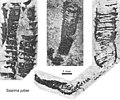The Deep Spring Formation is a geologic formation in Nevada. It preserves fossils dating back to the Ediacaran and Cambrian periods, like Wutubus and Elainabella.[3][4] It is also currently the only known Ediacaran Lagerstätten in the Southwestern United States.[3]
The first organism to be described from the Deep Spring Formation in 2014 was Elainabella in the Esmeralda Member, an enigmatic alga with similarities to green algae, suggesting that part of the formation was at one point a shallow marine environment or a microbial reef community.[4] More organisms would be described in 2016, most of which are ichnogenus' like Planolites, and even some tubular forms, like Wutubus, expanding not only the stratigraphic range of some of these forms, but also their biogeographic range.[3]
Color key
|
Notes Uncertain or tentative taxa are in small text; |
| Paleobiota | ||||
|---|---|---|---|---|
| Genus | Species | Notes | Images | |
| Costatubus[5] |
|
Tubular fossil, first occurrence in this formation and new species. | ||
| Conotubus |
|
Non-biomineral tubular fossil. | ||
| Gaojiashania |
|
Worm-like organism. | ||
| Saarina[5] |
|
Tubular fossil, first occurrence in this formation and new species. |  | |
| Wutubus |
|
Tubular fossil. | ||
| Elainabella[4] |
|
Enigmatic filamentous multicellular alga. |  | |
| Bergaueria? |
|
Resting place of Cnidarians. |  | |
| Neonereites? |
|
Burrows. |  | |
| Planolites |
|
Burrows. |  | |
| Scolicia? |
|
Burrows. |  | |